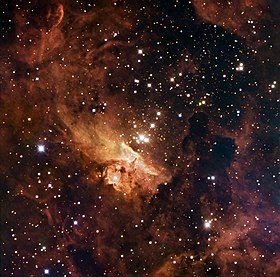 Pismis 24-1 is the brightest point of light at the centre of this optical image of the NGC 6357 region. Credit: ESO/IDA/Danish 1.5 m/ R. Gendler, U.G. Jørgensen, J. Skottfelt, K. Harpsøe | |
| Observation data Epoch J2000 Equinox J2000 | |
|---|---|
| Constellation | Scorpius |
| NE | |
| Right ascension | 17h 24m 43.497s[1] |
| Declination | –34° 11′ 56.86″[1] |
| Apparent magnitude (V) | 11.00[2] |
| SW | |
| Right ascension | 17h 24m 43.481s[1] |
| Declination | –34° 11′ 57.21″[1] |
| Apparent magnitude (V) | 11.10[2] |
| Characteristics | |
| NE | |
| Spectral type | O3.5If*[3] |
| Variable type | eclipsing[4] |
| SW | |
| Spectral type | O4III(f+)[3] |
| Astrometry | |
| Radial velocity (Rv) | −2.0[5] km/s |
| Proper motion (μ) | RA: −0.1[6] mas/yr Dec.: −1.3[6] mas/yr |
| Distance | 6,500[7] ly (2,000[7] pc) |
| Absolute magnitude (MV) | −7.50[3] |
| NE | |
| Absolute magnitude (MV) | −6.41[4] |
| SW | |
| Absolute magnitude (MV) | −6.28[4] |
| Details | |
| NE | |
| Mass | 74[1] M☉ |
| Radius | 18 R☉ |
| Luminosity | 776,000[1] L☉ |
| Temperature | 42,500/41,500[4] K |
| SW | |
| Mass | 66[1] M☉ |
| Radius | 17 R☉ |
| Luminosity | 646,000[1] L☉ |
| Temperature | ~40,000[1] K |
| Other designations | |
| NE: Pismis 24-1NE, HD 319718A | |
| SW: Pismis 24-1SW, HD 319718B | |
| Database references | |
| SIMBAD | data |
Pismis 24-1, also known as HD 319718, is the brightest star of the open cluster Pismis 24 within the nebula NGC 6357 about 6,500 light-years away. It was once thought to be the most massive star known, but is composed of at least three individual objects, each still among the most luminous and most massive stars known.
- ^ a b c d e f g h i Fang, M.; Van Boekel, R.; King, R. R.; Henning, T.; Bouwman, J.; Doi, Y.; Okamoto, Y. K.; Roccatagliata, V.; Sicilia-Aguilar, A. (2012). "Star formation and disk properties in Pismis 24". Astronomy & Astrophysics. 539: A119. arXiv:1201.0833. Bibcode:2012A&A...539A.119F. doi:10.1051/0004-6361/201015914. S2CID 73612793.
- ^ a b Skiff, B. A. (2014). "VizieR Online Data Catalog: Catalogue of Stellar Spectral Classifications (Skiff, 2009-2014)". VizieR On-line Data Catalog: B/Mk. Originally Published in: Lowell Observatory (October 2014). 1. Bibcode:2014yCat....1.2023S.
- ^ a b c Maíz Apellániz, J.; Walborn, Nolan R.; Morrell, N. I.; Niemela, V. S.; Nelan, E. P. (2007). "Pismis 24-1: The Stellar Upper Mass Limit Preserved". The Astrophysical Journal. 660 (2): 1480–1485. arXiv:astro-ph/0612012. Bibcode:2007ApJ...660.1480M. doi:10.1086/513098. S2CID 15936535.
- ^ a b c d Barr Domínguez, A.; Chini, R.; Pozo Nuñez, F.; Haas, M.; Hackstein, M.; Drass, H.; Lemke, R.; Murphy, M. (2013). "Eclipsing high-mass binaries. I. Light curves and system parameters for CPD - 51° 8946, PISMIS 24-1, and HD 319702". Astronomy & Astrophysics. 557: A13. arXiv:1306.5482. Bibcode:2013A&A...557A..13B. doi:10.1051/0004-6361/201321642. S2CID 118623790.
- ^ Crampton, D. (1972). "Radial velocities of southern B stars determined at the Radcliffe Observatory - VI. Stars in H II regions". Monthly Notices of the Royal Astronomical Society. 158: 85–98. Bibcode:1972MNRAS.158...85C. doi:10.1093/mnras/158.1.85.
- ^ a b Høg, E.; Fabricius, C.; Makarov, V. V.; Urban, S.; Corbin, T.; Wycoff, G.; Bastian, U.; Schwekendiek, P.; Wicenec, A. (2000). "The Tycho-2 catalogue of the 2.5 million brightest stars". Astronomy and Astrophysics. 355: L27. Bibcode:2000A&A...355L..27H. doi:10.1888/0333750888/2862.
- ^ a b Lima, E. F.; Bica, E.; Bonatto, C.; Saito, R. K. (2014). "Probing embedded star clusters in the HII complex NGC 6357 with VVV". Astronomy & Astrophysics. 568: A16. arXiv:1406.2413. Bibcode:2014A&A...568A..16L. doi:10.1051/0004-6361/201323050. S2CID 56229887.